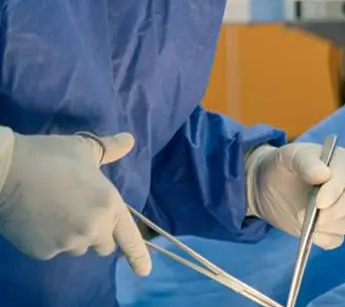Pfannenstiel incisions are horizontal skin incisions made over the symphysis pubis (pubic bone). This is the most common type of skin incision that is done during a cesarean section, and it is sometimes referred to as the "bikini cut." It is a form of surgical incision made in the abdomen that provides access to the abdominal cavity. It is currently the standard procedure for performing Caesarean sections as well as other gynecologic procedures. This incision is also utilized in orthopedic procedures using the Stoppa method to repair pelvic fractures.
Pfannenstiel Incision Definition
This incision is done horizontally right above the pubis. The anterior rectus sheaths as well as the linea alba are cut and then reflected upward between 8 to 10 centimeters. Midline incisions are made in the transversalis fascia and peritoneum, and the rectus muscles are retracted laterally. It's important to recognize and safeguard the iliohypogastric nerve.
Pfannenstiel Incision Technique
Your abdominal incision will either be:
Horizontal
95% of cesarean sections performed these days involve a low-transverse incision, also known as a "bikini cut." This is due to the fact that it is performed over the lower, thinner portion of the uterus, which results in less bleeding. It is also less likely to rupture if you attempt a vaginal birth after a cesarean delivery of a future child.

Vertical
This incision runs along the middle of the uterus and is additionally known as a "traditional" C-section. It was once frequent, but today it's usually only used in specific circumstances. For instance, it may be performed for prematurity, if the baby is positioned abnormally low in the uterus, or if a situation needs immediate delivery. The pain and recovery time from a vertical incision may be marginally higher than those from other types of wounds.
Pfannenstiel Incision Steps
Several techniques exist for successfully completing a cesarean section
- The Pfannenstiel-Kerr procedure includes the Pfannenstiel incision, which is a transverse skin incision that is made two fingers above the symphysis pubis
- This incision is then carried in the area of the anterior superior iliac spine (ASIS), and it finishes between two and three centimeters medial to the ASIS on both sides
- Sharp dissection is used to open the subcutaneous layer, which is then accompanied by a sharp extension of the fascia, a shallow uterine incision, and a blunt entrance
- After the placenta has been removed by hand, the uterine incision is closed using an interrupted single-layer closure technique
- Following the closure of the peritoneum and fascia, the adipose layer is not closed and the skin is sealed continuously.
Pfannenstiel Incision Location
The Pfannenstiel approach involved making an incision in the skin about 2 cm above the symphysis, with its midpoint located within the region of the pubic hairs that had been shaved.
Pfannenstiel Incision Scar
The term "bikini line incision" is widely used to refer to this particular cut. Perinatal delivery and hernia repair are two of the most common surgical procedures that require such access. Due to the scar being covered by pubic hair, it is frequently chosen over other incision types for aesthetic reasons. The incision heals more quickly than the conventional vertical incision and does not damage the belly button.






0 Comments
For comments please reply here.......